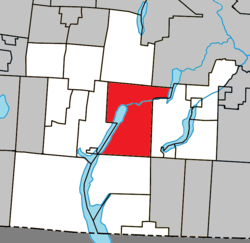Magog, Quebec
| Magog | ||
|---|---|---|
| City | ||

The skyline of the city of Magog.
|
||
|
||
| Motto: Fidelitate et Labore(Latin) "Through faithfulness and labour." |
||
 Location within Memphrémagog RCM. |
||
| Location in southern Quebec. | ||
| Coordinates: 45°16′N 72°09′W / 45.267°N 72.150°WCoordinates: 45°16′N 72°09′W / 45.267°N 72.150°W | ||
| Country |
|
|
| Province |
|
|
| Region | Estrie | |
| RCM | Memphrémagog | |
| Constituted | October 9, 2002 | |
| Government | ||
| • Mayor | Vicki May Hamm | |
| • Federal riding | Brome—Missisquoi | |
| • Prov. riding | Orford | |
| Area | ||
| • Total | 167.50 km2 (64.67 sq mi) | |
| • Land | 144.19 km2 (55.67 sq mi) | |
| Population (2011) | ||
| • Total | 25,358 | |
| • Density | 175.9/km2 (456/sq mi) | |
| • Pop 2006-2011 |
|
|
| • Dwellings | 13,605 | |
| Time zone | EST (UTC−5) | |
| • Summer (DST) | EDT (UTC−4) | |
| Postal code(s) | J1X | |
| Area code(s) | 819 and 873 | |
| Highways |
|
|
| Website | www |
|
Magog (local /ˈmeɪɡɔːɡ/; [maˈɡɔɡ]) is a city in southeastern Quebec, Canada, about 120 kilometres (75 mi) east of Montreal at the confluence of Lake Memphremagog—after which the city was named—with the Rivière aux Cerises and the Magog River. It is a major centre and industrial city in the Regional County Municipality of Memphremagog. The city lies in the Eastern Townships tourist region.
In 2002 the City of Magog was merged with the Township of Magog and the Village of Omerville as part of the municipal reorganization in Quebec.
"Memphremagog" comes from the Abenaki word mamhlawbagak, which means "large expanse of water" or "vast lake." "Magog" is believed to be a truncation of the lake's name. However, it could also come from namagok and namagwôttik, which mean "the lake where there is brook trout." Others have theorised that the name has Biblical origins in Gog and Magog, or that it refers to an ancient city by the same name.
The Abenaki were the first to inhabit the region and had long visited the Memphremagog and its waterways. The town was founded in 1776, when Loyalists emigrated from nearby Vermont. They called it The Outlet, referring to the flow of water emptying into the Magog River from the lake.
...
Wikipedia


